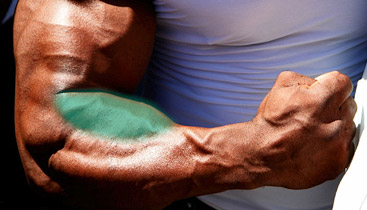THE BEST BRACHIORADIALIS EXERCISES FOR BIGGER FOREARMS

If you’re like most typical “hardgainers” with naturally thin forearms that just don’t seem to grow, or you’re just someone who is specifically interested in building bigger forearms, including some direct brachioradialis work into your plan is an effective way to maximize your gains in that area.
Not to be confused with the “brachialis” (an upper arm muscle that sits underneath the biceps), the brachioradialis is a thick band of muscle that runs from the very bottom of the upper arm and along the top of the forearm on the inner side.
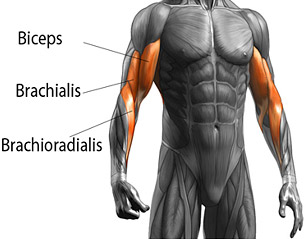
If you really want to achieve that thick, powerful look that a set of bigger forearms can create, well-developed brachioradialis muscles definitely play an important role.
So, what is the best way to get an effective brachioradialis workout?
How To Target The Brachioradialis Muscle
In order to determine which exercises will be best for targeting a particular muscle, we first need to take a look at the specific function that muscle performs.
Just like the biceps and the brachialis, the primary function of the brachioradialis is to flex the elbow.
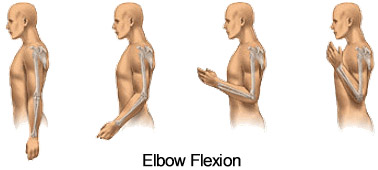
However, the brachioradialis only becomes a primary elbow flexor when you perform your curling movements with your hands in a neutral position (midway between supinated and pronated) or facing down (pronated).
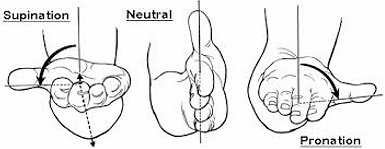
Doing so places the biceps at a mechanical disadvantage and forces the brachioradialis to take on more of the workload.
For example, as you read this, try performing a basic curling motion with your palm facing up, making sure to flex hard at the top. You should feel your bicep contract hard, with some secondary activation in the brachioradialis.
Next, perform a curling motion with your hand in a neutral position (again, flexing at the top), and then another with your palm facing down. In both of these cases you should feel the opposite; a strong contraction in the brachioradialis and secondary stress on the biceps.
So, in order to stimulate the brachioradialis muscle as effectively as possible and build bigger forearms, you’ll want to place your focus on two main exercises: hammer curls and reverse curls.
These curling exercises utilize a neutral grip and pronated grip respectively, and are therefore the best ways of targeting this muscle.
There are many different variations out there when it comes to hammer curls and reverse curls (such as dumbbell, barbell, cable; as well as standing, seated, or using a bench), and all of them are effective when done using proper form and intensity,
However, if I had to narrow it down, these would be my top two picks…
The 2 Best Brachioradialis Exercises
#1 – Cable Hammer Curls w/ Rope Attachment
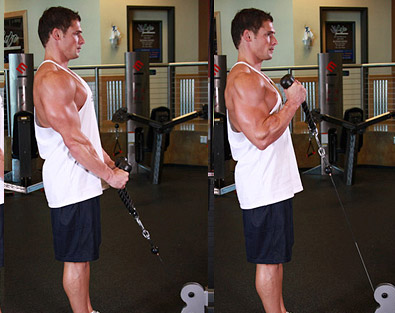
This is my top pick when it comes to hammer curl exercises, as the cable version allows you to maintain constant tension on the brachioradialis throughout the entire movement.
The execution for these is the same as a regular dumbbell hammer curl, except that you’ll be using a rope attachment set at the bottom of a cable machine.
Take a large step back, and hold onto the rope using a neutral grip with your hands spaced slightly inside of shoulder width.
From there, simply curl the rope up until you feel a strong contraction in your brachioradialis, and then lower it back down before repeating.
Here are a few quick tips to help you maximize the effectiveness of the exercise:
* Don’t allow your elbows and shoulders to drift forward excessively as you curl the rope up, as this will shift more of the emphasis onto the front delts.
* Keep your elbows tucked in toward your sides and don’t let them flare outward.
* Contract your triceps at the bottom of each rep to maximize the range of motion.
If you don’t have access to cables, a regular dumbbell hammer curl will still be highly effective, and you can use that variation instead.
Dumbbell hammer curls work well either from a regular standing position or when done on a preacher curl bench. You can test out both to see which version you prefer.
#2 – Reverse EZ-Bar Cable Curls
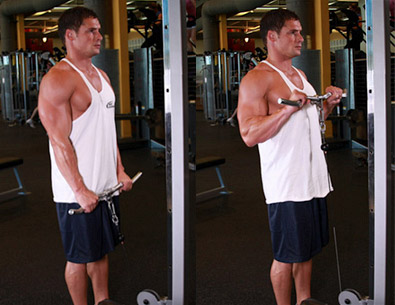
When it comes to reverse curls, the cable variation using an ez-bar attachment would be my go-to choice.
Once again, the cable version will allow for more consistent tension on the muscle, and the slightly angled handles of the ez-curl bar will place less pressure on the wrists in comparison to a straight bar.
Simply attach an ez-curl bar to the bottom of the cable machine and grab onto it using an overhand grip on the angled portion of the bar. Unlike the picture above, I prefer to use a thumbless grip for these as I find that this technique further increases brachioradialis activation.
From there, simply curl the weight up and down as you would for a normal bicep curl. (The same 3 form tips I outlined above for the hammer curls also apply to this movement as well)
Again, if you don’t have access to cables, you can perform this same movement using a regular free weight ez-curl bar, dumbbells, or a straight bar as long as it feels comfortable for you. In addition, these can all be done standing or on a preacher curl bench.
Are Direct Brachioradialis Exercises Necessary For Everyone?
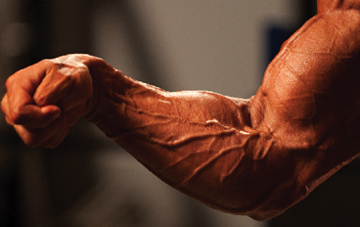
Keep in mind that the brachioradialis already receives a decent amount of stimulation during standard curling movements for the biceps, as well as during vertical and horizontal pulling movements for the back, particularly when the hands are pronated.
For that reason, direct training of this muscle is not a “must” for everyone, and it just comes down to you and your individual training goals.
I’d recommend including one or both of the exercises I outlined above in your workouts if:
1) You already have a reasonable amount of training experience but find that your forearms are clearly lacking in size and you want to improve their development.
2) Building bigger forearms is a specific goal of yours and you want to fully maximize your gains in that area.
As a general guideline, these exercises can be done 1-2 times per week for 2-3 sets of 8-10 reps each.
On the other hand, if you’re still a relative beginner without a lot of experience who is just aiming to build up overall size and strength, direct brachioradialis workouts shouldn’t be much of a concern for you at this point.
Just focus on making total body gains with the more basic foundational exercises using progressive overload, and later on you can include some direct work for this muscle if necessary.
Also, if you’re wondering why I didn’t include wrist curls as a recommended forearm exercise, check out my video on why you should avoid wrist curls & wrist extensions.
If you found this article helpful, make sure to sign up for your FREE custom fitness plan below...


